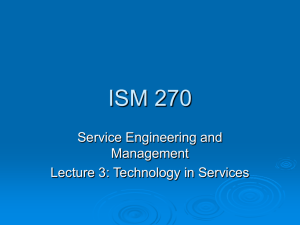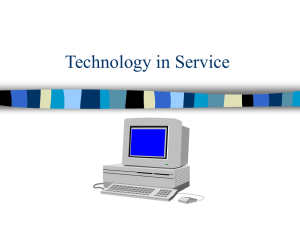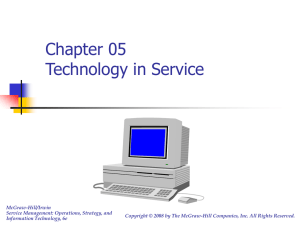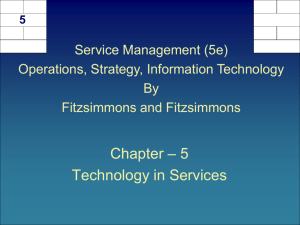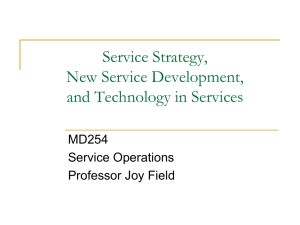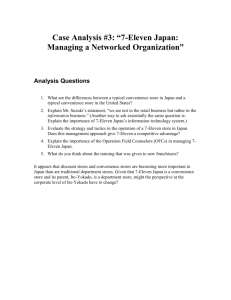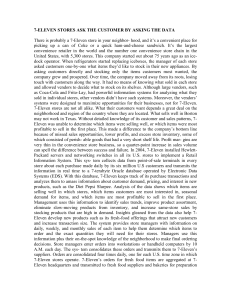Role of Services in an Economy
advertisement
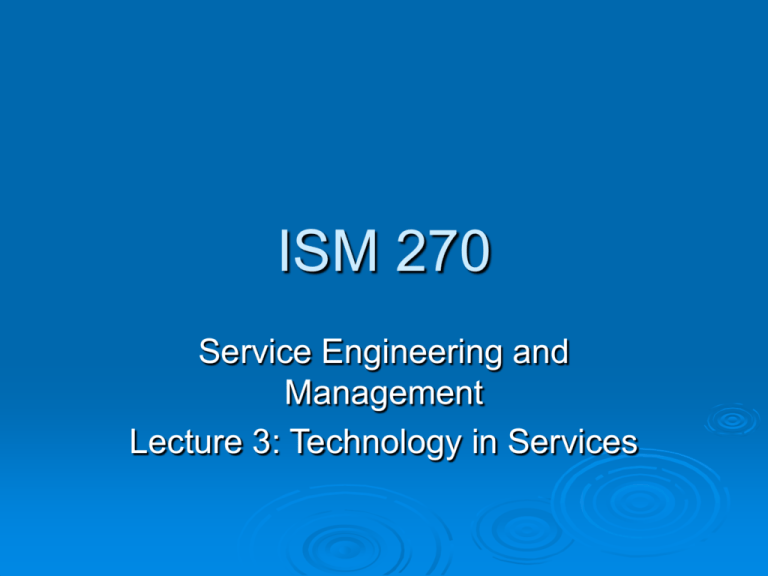
ISM 270 Service Engineering and Management Lecture 3: Technology in Services Announcements Homework 1 due today Homework 2 due next week 1/31 Today’s Lecture Role of Technology in Services, especially in new service development Dr Charles Ng, Demandtec Discussion Name an Internet site you believe will be successful in the long run - explain why. Technology in Service What roles can technology play? Role of Technology in the Service Encounter Technology Customer Technology Server A. Technology-Free Service Encounter Customer Technology Server B. Technology-Assisted Service Encounter Technology Customer Customer C. Technology-Facilitated Service Encounter Technology Server D. Technology-Mediated Service Encounter Customer Server Server E. Technology-Generated Service Encounter Technology has led to the Evolution of Self-service Service Industry Human Contact Machine Assisted Service Electronic Service Banking Teller ATM Online banking Grocery Checkout clerk Self-checkout station Online order/ pickup Airlines Ticket agent Check-in kiosk Print boarding pass Restaurants Wait person Vending machine Online order/ delivery Movie theater Ticket sale Kiosk ticketing Pay-for-view Book store Information clerk Stock-availability terminal Online shopping Education Teacher Computer tutorial Distance learning Gambling Poker dealer Computer poker Online poker Self-service Technologies (SST) Does customer adoption of self-service follow a predictable pattern? How do we measure self-service quality (e.g., ease of use, enjoyment, and/or control)? What is the optimal mix of SST and personal service for a service delivery system? How do we achieve continuous improvement when using SST? What are the limits of self-service given the loss of human interaction? Self-Service examples Airline industry Technology has led to service automation Fixed-sequence (F) - parking lot gate Variable-sequence (V) - ATM Playback (P) - answering machine Numerical controlled (N) - animation Intelligent (I) - autopilot Expert system (E) - medical diagnosis Totally automated system (T) - EFT Technology has led to a variety of services available via the web A retail channel (Amazon.com) Supplemental channel (Barnes & Nobel) Technical support (Dell Computer) Embellish existing service (HBS Press) Order processing (Delta Airline) Convey information (Kelly Blue Book) Organization membership (POMS.org) Games (Treeloot.com) Several technologies needed to converge to bring E-Business Internet Global telephone system Communications standard TCP/IP (Transfer Control Protocol/Internet Protocol) Addressing system of URLs Personal computers and cable TV Customer databases Sound and graphics User-friendly free browser E-Business has led to multiple business models (Weill & Vitale, Place to Space, HBS Press, 2001) Content Provider: Reuters Direct to Customer: Dell Full-Service Provider: GE Supply Co. Intermediary: eBay Shared Infrastructure: SABRE Value Net Integrator: 7-Eleven Japan Virtual Community: Monster.com Whole-of-Enterprise: Government Economics of E-Business Sources of Revenue: - Transaction fees - Information and advice - Fees for services and commissions - Advertising and listing fees Ownership - Customer relationship - Customer data - Customer transaction Electronic vs. Traditional Services Features Electronic Traditional Encounter Screen-to-face Face-to-face Availability Anytime Working hours Access From anywhere Travel to location Market Area Worldwide Local Ambiance Payment Electronic interface Credit card Physical environment Cash or check Differentiation Convenience Personalization Privacy Anonymity Social interaction Grocery Shopping Comparison On-line Shopping Advantages Convenience Saves time Less impulse buying Disadvantages Forget items Less control Need computer Delivery fee Traditional Shopping See new items Memory trigger Product sampling Social interaction Time consuming Waiting lines Carry groceries Impulse buying Economics of Scalability Dimensions High Scalability Low E-commerce continuum Selling information (E-service) Selling valueadded service Selling services with goods Selling goods (E-commerce) Information vs. Goods Content Information dominates Information with some service Goods with support services Goods dominate Degree of Customer Content Self-service Call center backup Call center support Call center order processing Standardization vs. Customization Mass distribution Some personalization Limited customization Fill individual orders Shipping and Handling Costs Digital asset Mailing Shipping Shipping, order fulfillment, and warehousing After-sales service None Answer questions Remote maintenance Returns possible Example Service Used car prices Online travel agent Computer support Online retailer Example Firm Kbb.com Biztravel.com Everdream.com Amazon.com E-Business Supply Chain (Network) Elements Major entities including firm of interest and its customers, suppliers, and allies Major flows of product, information, and money Revenues and other benefits each participant receives Critical aspects: participants, relationships, and flows Example: 7-Eleven Japan Japanese 7-Eleven Read case in text (p103, 6th edition, p122 5th edition) Evolution of B2C E-Commerce in Japan 1. 2. 3. 4. What features of the 7-Eleven Japan distribution system illustrate the “Value Net Integrator” e-business model? Does the 7-Eleven Japan distribution system exhibit scalability economics? How does the 7-Eleven example of B2C ecommerce in Japan illustrate the impact of culture on service system design? Will the 7-Eleven “Konbini and Mobile” system be adopted in the United States? New Service Development Video Levels of Service Innovation Radical Innovations Major Innovation: new service driven by information and computer based technology Start-up Business: new service for existing market New Services for the Market Presently Served: new services to customers of an organization Incremental Innovations Service Line Extensions: augmentation of existing service line (e.g. new menu items) Service Improvements: changes in features of currently offered service Style Changes: modest visible changes in appearances Technology Driven Service Innovation Power/energy - International flights with jet aircraft Physical design - Enclosed sports stadiums Materials - Astroturf Methods - JIT and TQM Information - E-commerce using the Internet Service Design Elements Structural - Delivery system - Facility design - Location - Capacity planning Managerial - Service encounter - Quality - Managing capacity and demand - Information New Service Development Cycle • Full-scale launch • Post-launch review Full Launch Development Enablers • Formulation of new services objective / strategy • Idea generation and screening • Concept development and testing People • Service design and testing • Process and system design and testing • Marketing program design and testing • Personnel training • Service testing and pilot run • Test marketing Design Product Technology Systems Tools Analysis • Business analysis • Project authorization Service Blueprint of Luxury Hotel Strategic Positioning Through Process Structure Degree of Complexity: Measured by the number of steps in the service blueprint. For example a clinic is less complex than a general hospital. Degree of Divergence: Amount of discretion permitted the server to customize the service. For example the activities of an attorney contrasted with those of a paralegal. Structural Alternatives for a Restaurant LOWER COMPLEXITY/DIVERGENCE CURRENT PROCESS No Reservations Self-seating. Menu on Blackboard Eliminate Customer Fills Out Form TAKE RESERVATION SEAT GUESTS, GIVE MENUS SERVE WATER AND BREAD TAKE ORDERS PREPARE ORDERS Pre-prepared: No Choice Salad (4 choices) Limit to Four Choices Entree (15 choices) Sundae Bar: Self-service Dessert (6 choices) Coffee, Tea, Milk only Serve Salad & Entree Together: Bill and Beverage Together Cash only: Pay when Leaving Beverage (6 choices) SERVE ORDERS COLLECT PAYMENT HIGHER COMPLEXITY/DIVERGENCE Specific Table Selection Recite Menu: Describe Entrees & Specials Assortment of Hot Breads and Hors D’oeuvres At table. Taken Personally by Maltre d’ Individually Prepared at table Expand to 20 Choices: Add Flaming Dishes; Bone Fish at Table; Prepare Sauces at Table Expand to 12 Choices Add Exotic Coffees; Sherbet between Courses; Hand Grind Pepper Choice of Payment. Including House Accounts: Serve Mints Taxonomy of Service Processes Low divergence (standardized service) No Customer Contact Processing of goods Processing Information Dry Cleaning Restocking a vending machine Check processing Billing for a credit card Processing of people Processing of goods Processing Information Auto repair Tailoring a suit Computer programming Designing a building Ordering groceries from a home computer Indirect customer contact No customerservice worker interaction (selfservice) Direct Customer Contact High divergence (customized service) Food service worker interaction Operating a vending machine Assembling premade furniture Giving a service in a restaurant Hand car washing Withdrawing cash from an ATM Providing lecture Handling routine bank transactions Processing of people Supervision of a landing by an air controller Operating an elevator Riding an escalator Home public transportation Providing mass vaccination Sampling food at a buffet dinner Bagging of groceries Documenting medical history Portrait carpet cleaning Landscaping service Haircutting painting Counseling Searching for information in a library Driving a rental car Using a health club facility Performing a surgical operation Generic Approaches to Service Design Production-line • Limit Discretion of Personnel • Division of Labor • Substitute Technology for People • Standardize the Service Customer as Coproducer • Self Service • Smoothing Service Demand Customer Contact • Degree of Customer Contact • Separation of High and Low Contact Operations Information Empowerment • Employee • Customer Customer Value Equation ResultsPro duced ProcessQua lity Value Price CostsofAcq uiringtheS ervice Amazon.com Discussion: What were / are the key drivers of success? What role has technology played? Discussion Name 1. 2. 3. An existing service that could be improved by new technology A new service that could be introduced if new technology were developed A technology that hasn’t yet converged to a service Aside: Transportation and Location Problems Appear frequently in service design Homework 2 has an example Clarke-Wright for homework 2 Traveling Salesman-type problems very common in services Delivery of goods Mail routes Sales tour Standard problem: Given the distance between each city pair, visit all N cities in some order, ending back at the base • Objective: Minimize total distance traveled Traveling salesman Standard problem is very difficult to solve (NP – complete) We will use the Clarke-Wright Algorithm (page 499 of text) C-W algorithm intuition: Start with the path that returns to base between every node Add links between nodes instead of returning in order of distance gained Stop when no gain can be made Note: This is a good heuristic Performs well in practice, but not guaranteed to find the best solution. Next Week Service Frank Quality Tung Charles Ng Optimization Engineer, DemandTec Previously: Vivecon Corporation, a startup in supply chain analytics. Ph.D. Stanford 2004 Management Science and Engineering Visiting researcher University of Geneva Researcher, International Institute of Applied Systems Analyses
